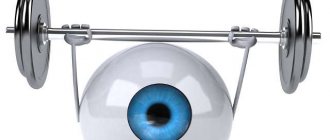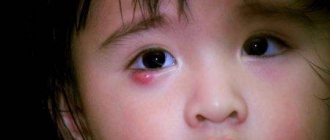In the treatment of eye diseases, the use of drops is a common practice. By themselves, they cannot replace a full-fledged correction, but they are quite capable of relieving discomfort and fatigue. For hypermetropia, both medicinal and vitamin local remedies can be used. It is important to ensure that the drug contains all the elements necessary to maintain visual function. Please note that only your treating ophthalmologist can prescribe medications and select their dosages. Otherwise, you risk not improving, but, on the contrary, aggravating the situation. Drops for farsightedness to improve vision are listed in the article.
What you need to know about hypermetropia
The basis of hypermetropia is changes in the eyeball, in which images of objects are focused in a plane located behind the retina, although ideally the picture should be focused on the retina. This happens due to an increase in the density of the lens, a shortening of the “apple” axis and insufficient refraction of light rays inside.
For newborn babies, normal farsightedness goes away on its own after a few weeks. If no changes occur, a diagnosis of “congenital hypermetropia” is made.
A decrease in visual acuity due to aging is common for people over 40 years of age and is called presbyopia (senile vision). Occurs in every third person. In patients over 55 years of age - almost everyone, with rare exceptions.
Useful video
Farsightedness (hypermetropia):
The benefits of gymnastics for farsightedness
Any muscle system with insufficient or monotonous load weakens, becomes flabby, loses firmness and elasticity. This fully applies to the eye muscles, which are responsible for both accommodation (“adjusting” the focus depending on the distance to the object) and for the movements of the eyeball in the orbit. Under constant and, very importantly, varied, dynamically changing loads, the ocular muscular system acquires sufficient tone to further change the curvature of the lens and, thus, provide such refraction of light that would compensate for the hypermetropic defect. In addition, regular eye exercises significantly stimulate the processes of blood circulation, metabolism, and tissue nutrition. It should be emphasized that the effectiveness of the exercises increases significantly if their regular implementation is combined with optimization of the diet: the ophthalmologist will instruct you in detail about which foods contain the vitamins, microelements and minerals necessary for the eyes.
Possible complications
Constant eye strain and increased intraocular pressure often cause glaucoma, which can lead to vision loss over time. The so-called “lazy eye syndrome”, amblyopia, often occurs, in which one eye becomes the dominant one and the brain perceives information coming only from it. This disorder occurs with prolonged progression of the disease, and the longer it persists, the more difficult it is to restore normal eye function.
Another functional disorder that causes significant inconvenience to the patient is a spasm of accommodation of the ciliary muscle. Appears when she is overtired (due to prolonged work at the computer, watching TV, etc.).
One more problem should be noted: the development, along with farsightedness, of myopia. Usually the disease develops separately, but it can also occur in the case of progressive farsightedness, which is not properly treated.
In this case, the person will have difficulty seeing both near and far, while correction with conventional glasses and lenses is impossible, and only a series of expensive operations can help.
Eye exercises for farsightedness
These exercises are designed not only to train accommodation, but also to improve the condition of the cervical spine - the structure in which the vessels feeding the eyeball, eye muscles and tissues surrounding the organ pass. By improving blood supply, a significant positive effect is also achieved.
Exercise No. 1
Take a sitting position, take a comfortable position, and relax as much as possible. The gaze is directed straight ahead. Slowly turn your head (and your gaze along with it, like a “searchlight beam”) to the right, then, smoothly returning to the starting position, turn to the left in a similar movement. Repeat at least ten times.
Exercise No. 2
The starting position is the same (see above). Bring your index finger to your eyes at a distance of thirty centimeters. For two seconds, look carefully “through” or past the finger into the distance, then focus your gaze on the tip of the finger and hold in this position for five seconds. Repeat ten times.
Exercise #3
Starting position – sitting on a chair with a straight back. The arms are bent and placed behind the back of the head. Bend back, as if stretching, placing both feet on your toes at the same time. Return to the starting position with your hands relaxed on your knees. Repeat the exercise seven to ten times.
Exercise #4
Starting position: sitting on a chair with your arms hanging freely at your sides. Smoothly raise both arms, pressing the palm of your right hand to your right shoulder, and your left hand to your left. Then extend your arms horizontally in front of you and slowly lower them to the starting position. Repeat the exercise five to eight times.
Exercise #5
Self-massage of the back of the head and neck. Starting position – sitting. Use your fingertips to firmly touch the back surfaces of your head and neck, as if playing a fast part on tight keys, gradually moving from top to bottom and back up.
Exercise #6
Starting position – sitting in a comfortable position. Extend your slightly bent right arm forward so that the distance from your eyes to your fingertips is fifty centimeters. Rotate your hand clockwise, following your fingers only with your eyes and keeping your head motionless. Likewise for the left hand. Repeat seven to eight times with each hand.
Why are ophthalmic solutions needed in treatment?
Eye solutions are prescribed by the attending physician, taking into account the person’s pathologies, complications, risks of complications and other factors, individual intolerance to certain drugs.
These drugs are used as one of the points of the treatment regimen that the doctor has selected: they should enhance the effectiveness of other drugs and complement each other, relieve tension and prevent the occurrence of infectious diseases.
How is farsightedness corrected?
Today, many methods have been developed that allow for complete or partial correction of hypermetropia. The most effective of them:
Optical correction. Glasses and contact lenses are the most common, simple and inexpensive way to correct farsightedness. They are quite convenient, but they have their drawbacks, and incorrectly selected glasses or contact lenses can lead to aggravation of the disease.
Gymnastics for the eyes. In the early stages of the disease, you can achieve serious results with the help of special exercises that will help improve blood supply to the eyes, correct the work of the necessary muscles and bring the organ of vision to an optimal state.
Lifestyle changes. To prevent the development of hypermetropia and the progression of the disease, it is necessary to observe the correct lighting regime (do not work in fluorescent lamps, use table lamps), alternate visual stress with physical exercise, adhere to the principles of a balanced diet so that the eyes receive the necessary vitamins and microelements in sufficient quantities.
Surgical treatment. If farsightedness is stable, the ophthalmologist may prescribe surgery performed using a laser.
This treatment method can achieve complete vision correction. By identifying the symptoms of hypermetropia in a timely manner, you can avoid a host of dangerous complications, including the development of glaucoma and, as a consequence, complete loss of vision.
What should be included?
There are two types of drops used for farsightedness:
- Drops based on organic components.
- Synthetic based drops
Among the plant components, blueberries stand out. If the patient’s eyes regularly experience increased stress (for example, he has to work at the computer all day or reads a lot), an increased dosage of the microelement riboflavin and retinol is recommended.
Almost all drugs contain a combination of several active substances: one substance enhances the effect of another, which has a positive effect on effectiveness.
Expert opinion
Danilova Elena Fedorovna
Ophthalmologist of the highest qualification category, Doctor of Medical Sciences. Has extensive experience in diagnosing and treating eye diseases in adults and children.
ATTENTION! Remember that only a specialist should prescribe medications. Do not buy medications based on the advice of a loved one or an article on the Internet - you can only make the situation worse and waste your money. Each drug has a number of contraindications, as well as side effects, and only an ophthalmologist can help clarify this issue. Children, adolescents, pregnant and breastfeeding women, elderly people with metabolic disorders and chronic diseases of the cardiovascular system should be especially careful.
How is farsightedness diagnosed?
To reliably diagnose farsightedness, a complete ophthalmological examination is necessary. Before making a diagnosis, the pupil is forcibly dilated with the help of cycloplegics (this makes it possible to identify hidden hypermetropia), after which the specialist carries out:
- refractometry, that is, measuring refraction using a refractometer;
- skiascopy - observation of the movement of a light spot in the pupil;
- visual acuity study.
Solutions for vision restoration
Taufon
The active component of Taufon drops is taurine. The older a person gets, the less of this valuable amino acid is produced in his body and the worse it affects the visual and other organs.
The drug helps normalize metabolism, supports the function of cell membranes, and accelerates the restoration of damaged tissues. Additionally, it improves the metabolic process in the eyes and is able to stabilize intraocular pressure. The substances in the drops contain 40%, the rest is purified water and auxiliary components.
Drops are used in a course: at least 3 times a year for preventive purposes (with a break of 4 weeks), it is especially recommended to use them in patients over 60 years of age. Not prescribed for adolescents under 18 years of age and pregnant women. The opened bottle is stored in the refrigerator, warming it in the hands before use. Sold without a prescription. Side effects – individual intolerance to the components. No overdoses were detected.
The cost of a 10 ml bottle (4%) starts from 116 rubles.
Taurine
The main component - the same taurine - has a regenerating and antioxidant effect, prevents the development of cataracts, and helps eliminate degenerative changes in the eyes. The course of treatment lasts up to 3 months, 2-3 drops are instilled 3 times per day. The drug is not prescribed to children, nursing or pregnant women.
IMPORTANT! When instilled, the patient may feel a slight burning sensation, which quickly passes. If discomfort persists for a long time, consult a doctor to change the drug.
5 ml bottle
Taurine is similar in action to Taufon, since the components are almost identical. However, Taurine will not help with glaucoma and lens clouding. The significant difference is in the manufacturer and price, since Taufon is a foreign analogue and costs significantly more.
Analogs: “Khrustain”, “Katachrome”, “Dibikor”.
Reticulin
A local drug that is often prescribed for age-related farsightedness as an aid. It increases accommodation, relieves eye strain, protects the cornea from dust and bacteria, and moisturizes it. Additionally, it normalizes metabolic processes in tissues and improves cell production. Can be used for preventive purposes. The course of treatment is at least a month.
Exercises for farsightedness according to the W. Bates system
This technique is quite strongly criticized by official medicine, but for informational purposes we present it. In any case, although the benefits are doubtful, there will be no worse results from performing these exercises.
At the beginning of the twentieth century, the American ophthalmologist William G. Bates proposed one of the first non-drug training systems for restoring hypermetropic vision. His book “Ideal vision without glasses” was fairly criticized by experts, and the most controversial points that did not correspond to modern ideas and scientific data were removed in subsequent editions. At the same time, the Bates complex has been widely practiced all over the world for about a hundred years, without losing its relevance and popularity.
W. G. Bates was based on his own many years of clinical experience and the results of his specially undertaken scientific research. The central point of his theory is the assumption that progressive farsightedness is caused by chronic overstrain of the ocular muscular system, which, when looking close, unsuccessfully tries to compensate for the congenital hyperopic failure. Accordingly, Bates believed that the best way to cope with stagnant tension was proper relaxation of the eye muscles. The main methodological technique is the so-called. “palming” (from the English “palm” - palm), i.e. alternately covering the eyes with the palms, accompanied by various accommodating and rotational movements of the eyeballs. In addition, Bates proposed a number of original, simple and effective techniques for switching, resting, and training the eye muscles. Some of these exercises are described below.
Exercise No. 1
Every day for fifteen minutes, without glasses, read a book with small print, and it should be held at a close (no further than 30 cm) distance from the eyes. It is recommended not to make your task easier with bright light, but to try to make out the letters in dim or normal lighting. All muscles of the body should be as relaxed as possible at this time. Even if in the first day or two the exercise seems completely impossible due to the illegibility of the “blurry” small letters, gradually the visual system will begin to adapt to difficult conditions and restore the natural ability to focus closely.
Exercise No. 2
Similar to the first exercise, but you should literally “read between the lines”, i.e. glide your gaze along the white spaces between the lines.
Exercise #3
A simple and effective technique, borrowed in various modifications by many other, later systems. It is better to do it in a garden, park, or at least near an open window to ensure the maximum possible flow of fresh air. Holding an open book in your hands, alternate between reading and looking at distant objects around you.
Exercise #4
An even simpler, but extremely beneficial activity for the eyes: watch the flight of birds! In principle, observing any moving object is useful, but birds, as a rule, abruptly change direction, speed, flight altitude - i.e. The background illumination changes dynamically, which creates additional conditions for training the eye’s ability to stably maintain focus on an object.
Exercise #5
Place a burning candle on a table or windowsill; It is desirable that the background (wallpaper, bars on the window) have vertical stripes. Starting position: stand straight, feet thirty centimeters wide. Focus your gaze on the candle flame. Slowly and smoothly turn to the left (including turning the head and gaze along with the movement of the shoulders) - as much as possible; A 180-degree rotation is desirable, even if this means lifting your heels slightly off the floor. Just as smoothly turn back, focus your gaze on the candle and, without taking a break, turn in the same way to the right. The approximate number of repetitions and pace of execution is sixteen turns per minute.
Vitamin drops
Kuspavit
A drug with a complex of minerals and vitamins, recommended for the treatment of farsightedness and further prevention of eye diseases. Ingredients: potassium sorbate, distilled water, plastoquinone, vitamin C, chlorophyll, sodium chloride. Kuspavit provides adequate nutrition to eye cells, improves tissue trophism, inhibits the decline in visual function, and stops inflammatory processes.
Course use of the drug allows you to protect the cornea from infectious agents and ultraviolet radiation, moisturizes it, and removes toxins. The course of treatment is 3 months (2 drops in each eye 3-4 times a day).
Contraindications: individual intolerance to the components and age under 14 years.
No overdoses have been recorded. Shelf life – 2 years. Stored at room temperature.
Bottle cost: from 670 rubles
Zorro
The drug improves metabolic processes and metabolism, moisturizes the cornea and relieves fatigue. Ingredients: sodium citrate, chamomile and green tea extracts, sodium chloride, water, sodium sorbate and hyaluronate, cytochrome.
The course of treatment is a month (2 drops per day).
Contraindications: patients with hypersensitivity to the components, pregnant and breastfeeding women. Stored at room temperature, shelf life – 30 days from the date of manufacture.
Cost of drops: 250-280 rubles per bottle.
IMPORTANT! “Zorro” drops are not a full-fledged medicine; they are dietary supplements that have been certified by the Ministry of Health of the Russian Federation and hygienic certification as a cosmetic tonic.
Sante 40
Japanese eye drops that improve the functioning of the visual system. Main components: pyridoxine, taurine, tocopherol, aminocaproic acid, chlorpheniramine maleate, panthenol and neostigmine methyl sulfate. Additional components: tone agent, polyoxyethylene, benzalkonium chloride, pH agent, castor oil, borneol, boric acid and sodium edetate.
Action of the drug:
- Improves blood circulation in tissues
- Relieves inflammation
- Improves cell nutrition
- Strengthens the walls of blood vessels
- Stimulates tissue oxygenation
Contraindications: for glaucoma; individual intolerance. Pregnant women and nursing mothers are prescribed only after examination by a specialist. Side effects: redness of the eyelids, itching, burning, rash and swelling. Stored at room temperature for no more than two years. Available without a prescription.
ATTENTION! If the patient has keratitis, uveitis and other inflammatory eye diseases, and there is a need to use other drops, Sante 40 cannot be used.
Analogs: Pilocarpine, Ciprofloxin, Tobrex.
Bottle cost: from 1300 rubles.
Oftan Katahrom
The medicine belongs to modern combination drugs. It consists of cytochrome, adenosine and nicotinamide. Additionally, the medicine includes sorbitol, sodium compounds, benzalkonium chloride.
All components of the product, acting simultaneously, have a pronounced positive effect. The drug helps improve metabolic processes inside the eye. Cytochrome is one of the types of enzymes synthesized in the body. It regulates all biochemical processes in the vitreous body of the organ of vision. Thanks to it, opaque proteins melt in the liquid. Adenosine is a source of energy; it is sent to the lens to normalize its activity.
Nicotinamide became the precursor of special proteins that destroy proliferative cells. Thanks to its action, patients with farsightedness do not develop strictures (narrowing) and muscle inflammation.
When using drops, the active components are not absorbed into the bloodstream and are concentrated on the surface of the cornea. Adenosine penetrates and accumulates in the lens.
The drug should not be prescribed to patients with intolerance to the components of the drug. Oftan is recommended to be used 3 times a day every 8 hours at a dose prescribed by the attending physician. The duration of therapy is 2-3 weeks.
During pregnancy and when feeding a baby, it is not recommended to use drops, since adenosine can penetrate the systemic bloodstream and the placenta, causing a teratogenic (impairing embryonic development) effect and the development of defects.
Side effects develop in 15% of patients as a result of incorrect dosage. Patients complain of burning and pain in the eyes. These symptoms go away on their own and do not require medical intervention. Severe complications (bronchial obstruction, nausea, repeated vomiting, drop in pressure) require immediate medical attention.
Combating complications of hypermetropia
Oftan katachrome
A combined drug that improves tissue metabolism and slows down pathological processes in the eyes. It has a reparative and antioxidant effect, accelerates tissue restoration after operations and injuries. Improves the transparency of the cornea, reduces the severity of symptoms.
Active ingredients: adenosine, nicotinamide, cytochrome C. Auxiliary ingredients: purified water, sorbitol, sodium dihydrogen phosphate dihydrate, benzalkonium chloride, sodium succinate hexahydrate.
Instillations are carried out three times a day, 1-2 drops into the conjunctival sac of each eye. Drops are produced in Finland and France. No overdoses have been identified. Allowed to be combined with other drugs.











